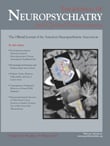Suggested Improvements to the Overt Aggression Scale-Modified
To the Editor: The lack of a standard efficacy measure for outpatient studies of impulsive aggression led Coccaro et al. 1 to modify the Overt Aggression Scale (OAS) 2 to create the OAS-Modified (OAS-M). The one large (N=246) study to date which used the OAS-M 3 found that the total aggression score had a large variance and was highly skewed, which prevented the use of parametric statistics including covariance analyses. The large variance and skewness seemed due to the scoring system—to calculate the aggression scores, frequencies are multiplied by severity ratings, but there is no upper limit on frequencies. Therefore a patient who has many episodes of relatively mild irritability can have a very high total aggression score, much higher than a patient who, less frequently, has much more serious aggression (this also impairs face validity). Also, the calculated aggression scores have not yielded better drug-placebo discrimination than the much simpler global ratings. 4 Given the above, and my prior experience with the OAS-M, I modified the OAS-M as follows:
| 1. | To improve face validity, reduce skewness, and limit the effect of high frequency of mild aggression, the scoring system was modified so that frequencies were categorized into one of five ratings (e.g., a score of 3 equals 4–10 times/week). | ||||
| 2. | Some of the descriptive anchor points seemed to require modification. For example, “engaged in a verbal argument with someone” was rated worse than “cursed or personally insulted someone.” The anchors were therefore changed to “mild,” “moderate,” and “severe,” with descriptions to illustrate each severity level. | ||||
| 3. | Because of the unclear relationships between aggression and suicidal behavior, 1 ratings of “assault against self” were eliminated. | ||||
| 4. | A “moderately severe” option was added to the Global Overt Irritability rating to create more of an interval scale, and slight changes in wording were made. | ||||
| 5. | The global ratings of overt aggression and subjective irritability were not combined (the two do not consistently correlate highly 1 ). | ||||
This revised OAS-M was then used in two fairly small placebo-controlled studies in outpatients with impulsive aggression, one with oxcarbazepine (N=48) 4 and one with levetiracetam (N=40). 5 Using the revised OAS-M resulted in clear and consistent evidence of benefit in the oxcarbazepine study (reliability can be inferred if a rating significantly discriminates an active medication from placebo). In the levetiracetam study, there was not a significant drug-placebo difference, but interrater reliability of the revised OAS-M was evaluated with 20 patients evaluated by two raters: Intraclass correlation coefficients were high (e.g., 0.918 for total aggression and 0.878 for global overt aggression, both significant at p<0.001). Supporting validity, correlations among the OAS-M measures and other aggression ratings were high in the levetiracetam study, and patient-rated global improvement and the hostility rating of the Brief Psychiatric Rating Scale also showed significant drug-placebo differences in the oxcarbazepine study.
Thus, the revised OAS-M seems more likely to discriminate between effective medication and placebo. Details about the rationale for the revised OAS-M (and a copy) can be obtained from the author ([email protected]).
1. Coccaro EF, Harvey PD, Kupsaw-Lawrence E, et al: Development of neuropharmacologically based behavior assessments of impulsive aggressive behavior. J Neuropsychiatry Clin Neuroscience 1991; 3:544–551Google Scholar
2. Yudofsky SC, Silver JM, Jackson W, et al: The Overt Aggression Scale for the objective rating of verbal and physical aggression. Am J Psychiatry 1986; 143:35–39Google Scholar
3. Hollander E, Tracy KA, Swann AC, et al: Divalproex in the treatment of impulsive aggression: efficacy in cluster B personality disorders. Neuropsychopharmacology 2003; 28:1186–1197Google Scholar
4. Mattes JA: Oxcarbazepine in patients with impulsive aggression: a double-blind, placebo controlled trial. J Clin Psychopharmacology 2005; 25:575–579Google Scholar
5. Mattes JA: Levetiracetam in patients with impulsive aggression: a double-blind, placebo controlled trial. J Clin Psychiatry 2008; 69:310–315Google Scholar



